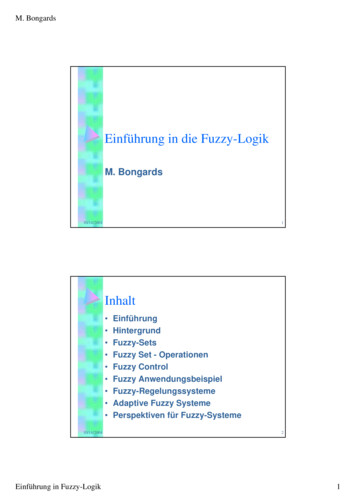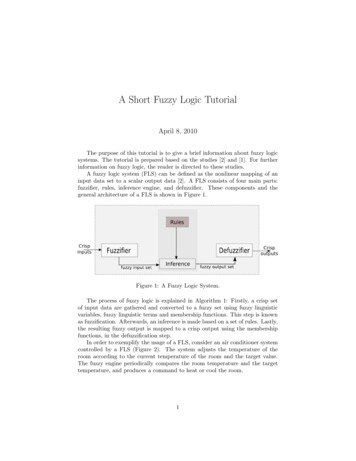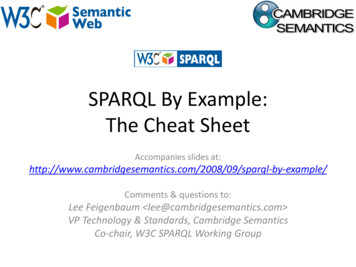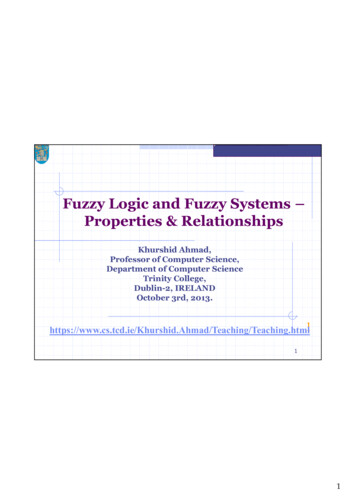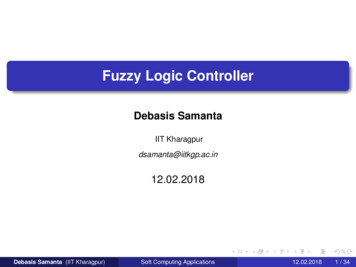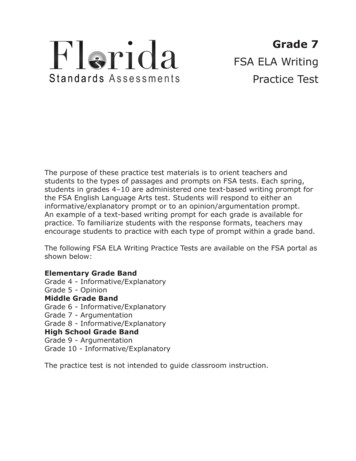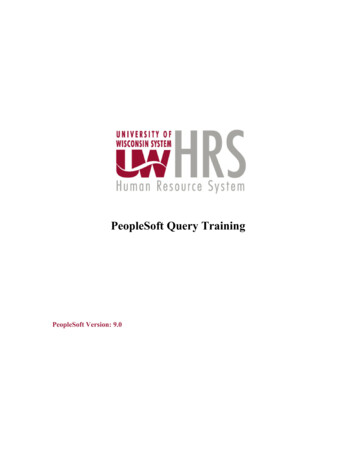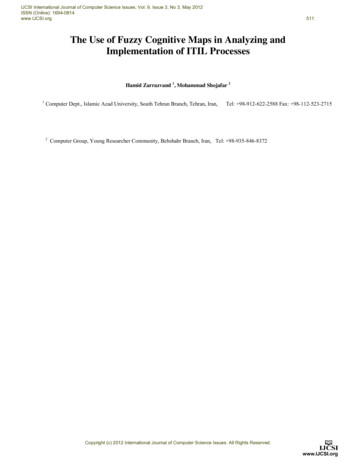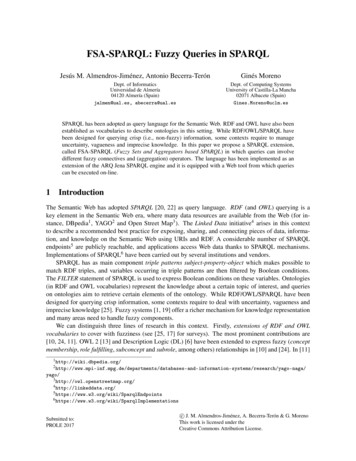
Transcription
FSA-SPARQL: Fuzzy Queries in SPARQLJesús M. Almendros-Jiménez, Antonio Becerra-TerónGinés MorenoDept. of InformaticsUniversidad de Almería04120 Almería (Spain)jalmen@ual.es, abecerra@ual.esDept. of Computing SystemsUniversity of Castilla-La Mancha02071 Albacete (Spain)Gines.Moreno@uclm.esSPARQL has been adopted as query language for the Semantic Web. RDF and OWL have also beenestablished as vocabularies to describe ontologies in this setting. While RDF/OWL/SPARQL havebeen designed for querying crisp (i.e., non-fuzzy) information, some contexts require to manageuncertainty, vagueness and imprecise knowledge. In this paper we propose a SPARQL extension,called FSA-SPARQL (Fuzzy Sets and Aggregators based SPARQL) in which queries can involvedifferent fuzzy connectives and (aggregation) operators. The language has been implemented as anextension of the ARQ Jena SPARQL engine and it is equipped with a Web tool from which queriescan be executed on-line.1IntroductionThe Semantic Web has adopted SPARQL [20, 22] as query language. RDF (and OWL) querying is akey element in the Semantic Web era, where many data resources are available from the Web (for instance, DBpedia1 , YAGO2 and Open Street Map3 ). The Linked Data initiative4 arises in this contextto describe a recommended best practice for exposing, sharing, and connecting pieces of data, information, and knowledge on the Semantic Web using URIs and RDF. A considerable number of SPARQLendpoints5 are publicly reachable, and applications access Web data thanks to SPARQL mechanisms.Implementations of SPARQL6 have been carried out by several institutions and vendors.SPARQL has as main component triple patterns subject-property-object which makes possible tomatch RDF triples, and variables occurring in triple patterns are then filtered by Boolean conditions.The FILTER statement of SPARQL is used to express Boolean conditions on these variables. Ontologies(in RDF and OWL vocabularies) represent the knowledge about a certain topic of interest, and querieson ontologies aim to retrieve certain elements of the ontology. While RDF/OWL/SPARQL have beendesigned for querying crisp information, some contexts require to deal with uncertainty, vagueness andimprecise knowledge [25]. Fuzzy systems [1, 19] offer a richer mechanism for knowledge representationand many areas need to handle fuzzy components.We can distinguish three lines of research in this context. Firstly, extensions of RDF and OWLvocabularies to cover with fuzziness (see [25, 17] for surveys). The most prominent contributions are[10, 24, 11]. OWL 2 [13] and Description Logic (DL) [6] have been extended to express fuzzy (conceptmembership, role fulfilling, subconcept and subrole, among others) relationships in [10] and [24]. In [11]1 http://wiki.dbpedia.org/2 d-information-systems/research/yago-naga/yago/3 http://owl.openstreetmap.org/4 http://linkeddata.org/5 https://www.w3.org/wiki/SparqlEndpoints6 tted to:PROLE 2017c J. M. Almendros-Jiménez, A. Becerra-Terón & G. MorenoThis work is licensed under theCreative Commons Attribution License.
2FSA-SPARQL: Fuzzy Queries in SPARQLaggregation operators have also been integrated in OWL and DL. Secondly, fuzzy DL reasoners. Themost relevant fuzzy reasoners are fuzzyDL [9], DeLorean [8] and Fire [23]. And finally, querying of fuzzyontologies with SPARQL extensions [12, 26, 16, 23, 7].Here, we focus on a SPARQL extension to cover with fuzziness. SPARQL fuzzy extensions (see [21]for a survey) are mainly represented by f-SPARQL [12, 26, 16]. In f-SPARQL fuzzy terms (for instance,RECENT, HIGH and VERY), and fuzzy operators (for instance, CLOSE TO and AT LEAST) might appearin FILTER conditions to relax SPARQL queries. Fuzzy predicates are based on trapezoidal membershiprelations. RDF data can contain in f-SPARQL fuzzy values in the form of real numbers of the [0,1]interval for some data property. Weighted mean is used to combine partial scores and the weights arespecified by the WITH statement in FILTER conditions. For instance, the following query:SELECT ?Movie ?Actor ?Date ?RatingWHERE {?Actor movie:actor-name "George Clooney".?Movie movie:actor ? Actor .?Movie dc:date ? Date .?Movie dc:rate ? Rating .FILTER (?Date recent) WITH 0.8.(?Rating high) WITH 0.2.}retrieves the recent (importance 0.2) movies featuring George Clooney with a high rating (importance0.8). Top-k solutions can be reported in f-SPARQL. f-SPARQL queries are translated into BooleanSPARQL queries, which can be executed by any SPARQL interpreter.On the other hand, the FSAQL query language has been proposed in [7], which resembles SPARQLand it is able to query fuzzy values assigned to RDF statements. Additionally, the authors of [23] propose a SPARQL-based encoding of conjunctive queries expressed in fuzzy DL. Top-k [18] and skylinequeries [14] have also been studied in extensions of SPARQL. Finally, the PrefSPARQL extension ofSPARQL proposed in [14] introduces user preferences in the FILTER clause with the PREFERRINGand PRIOR TO clauses as well as with the introduction of HIGHEST, LOWEST, IF-THEN-ELSE, BETWEEN, AROUND, MORE THAN and LESS THAN operators.In this paper we propose a SPARQL extension, called FSA-SPARQL (Fuzzy Sets and Aggregatorsbased SPARQL) in which queries can involve different fuzzy (Product, Łukasiewicz and Gödel) connectives, fuzzy operators VERY, MORE OR LESS, CLOSE TO, AT MOST and AT LEAST, as well asfuzzy aggregation operators also called aggregators: MEAN, WSUM, WMIN and WMAX. FSA-SPARQLworks on fuzzy RDF data, handling fuzzy concept membership, fuzzy role fulfilling, fuzzy subconceptand fuzzy subrole relationships. Thus, FSA-SPARQL is a fuzzy query language on fuzzy data. FSASPARQL queries are translated into crisp (that is, standard or non-fuzzy) SPARQL queries, and thusFSA-SPARQL queries can be executed by any SPARQL interpreter. Additionally, FSA-SPARQL enables also to specify a threshold on queries.FSA-SPARQL amalgamates the proposed f-SPARQL [12] operators (i.e., VERY, MORE OR LESS,CLOSE TO, AT MOST and AT LEAST) together with the fuzzy OWL 2 aggregation operators [11] (i.e.,MEAN, WSUM, WMIN and WMAX). FSA-SPARQL is inspired by our previous works on XPath/XQueryand the fuzzy (multi-adjoint) logic programming language MALP [3, 2, 5, 4]. While in the case of XPath(and XQuery) the goal was to incorporate fuzzy logic connectives and aggregators into both languagesin order to work with XML data, here our proposal aims to represent data and queries by RDF andSPARQL, respectively.The differences with regard to f-SPARQL [12] is that here we deal with fuzzy concept membership,
J. M. Almendros-Jiménez, A. Becerra-Terón & G. Moreno3fuzzy role fulfilling, fuzzy subconcept and fuzzy subrole relationships. For instance, we can now expressthat George Clooney is an actor with a degree of 1, while he is a TV movie actor with a degree of 0.4.We can also express that George Clooney is the leading role of Ocean’s Eleven with a degree of 0.4.Also we can express that a movie producer is a subconcept of artist with a degree of 0.4, as well as a castpartner is a subrole of friend with a degree of 0.4. This kind of fuzzy specifications cannot be definedin f-SPARQL. Additionally, connectives coming from standard fuzzy logics (i.e., Łukasiewicz, Productand Gödel logics) and fuzzy aggregators (i.e., MEAN, WSUM, WMIN and WMAX) cannot be used inf-SPARQL. Our language has also greater expressivity power than FSAQL [7] enabling the use of fuzzyconnectives and (aggregation) operators.With regard to data, RDF data has been equipped with truth values associated to concept membership,role fulfilling, subconcept relationships and subrole relationships. Thus, our data model is similar to theFSAQL data model. We have adopted a simple data model, but it has several advantages. Firstly, the datamodel has a RDF/XML serialization which is compatible with Protégé [15] and other ontology tools, andalso fuzzy data can be edited and partially debugged 7 (via ontology reasoners) with Protégé. The fuzzyOWL 2 proposal of [10] uses OWL annotations to specify fuzzy data, and the RDF/XML serialization iscompatible with Protégé but, since editing is not supported by Protégé, a plugin must be used.8 In thecase of [24], the RDF/OWL serialization is not compatible with Protégé. Secondly, SPARQL queries(and FSA-SPARQL queries) can be easily expressed against our data model. The authors of [10] have notstill studied how to use SPARQL for expressing queries against their fuzzy OWL 2 proposal. The authorsare mainly concerned at using a fuzzy DL reasoner on fuzzy OWL 2 data. Fuzzy OWL annotations,which are essentially XML annotations, make harder the specification of queries with SPARQL. Thisis the main reason we have not adopted the fuzzy OWL 2 proposal. While fuzzy OWL 2 offers a widerange of mechanisms to describe fuzzy data, our approach is restricted to truth values (real numbers ofthe [0,1] interval) associated to rdf:type, rdfs:subClassOf and rdfs:subPropertyOf axioms, as well as toobject/data property relationships. Our proposal is also inspired by [11], where authors introduce fuzzysets and aggregators in DL. However, our work is focused on extending SPARQL with fuzzy aggregators,in such a way that the user can play with them to express preferences.We have developed a Web tool9 from which FSA-SPARQL can be executed on-line. The implementation of FSA-SPARQL has been carried out on top of ARQ Apache Jena engine.10 On the onehand, fuzzy connectives and operators have been incorporated to ARQ Jena using the Expression Functions mechanism. On the other hand, FSA-SPARQL queries are translated into crisp SPARQL enrichedby fuzzy connectives and operators. In order to provide semantics to FSA-SPARQL we will define amapping from FSA-SPARQL to (pure) crisp SPARQL.The structure of the paper is as follows. Section 2 motivates the framework with some examples. InSection 3 we describe the extension of RDF to cover fuzziness. Section 4 presents FSA-SPARQL and itssemantics based on a FSA-SPARQL to crisp SPARQL transformation as well as the developed Web toolto execute FSA-SPARQL queries on-line. Finally, in Section 5 we conclude and present future work.7 Currentcrisp (non-fuzzy) OWL reasoners can be used to partially debug our fuzzy RDF, while a more complete andsophisticated mechanism is out of the scope of the paper, and it is considered as future work.8 /9 http://minerva.ual.es:8080/FSASPARQL10 html
42FSA-SPARQL: Fuzzy Queries in SPARQLMotivationFuzzy sets and aggregators can be used to express fuzzy SPARQL queries as follows. Firstly, Booleanconnectives can be replaced by Product, Łukasiewicz and Gödel conjunctions and disjunctions. Secondly, fuzzy (binary) aggregators (i.e., MEAN, WSUM (Weighted sum), WMIN (Weighted minimum)and WMAX (Weighted maximum)) can be used to express user preferences. Finally, fuzzy operators(i.e., VERY, MORE OR LESS, CLOSE TO, AT MOST and AT LEAST) can be used to play with fuzzyvalues. For instance, the following FSA-SPARQL query:SELECT ?Name ?RankWHERE {?Movie movie:name ?Name .?Movie movie:leading role (?Actor ?l) .?Actor movie:name "George Clooney".{?Movie f:type (movie:Thriller ?c)} UNION{?Movie f:type (movie:Comedy ?c)} .?Movie f:type (movie:Good ?r) .BIND(f:OR GOD(f:AND LUK(?r,?l),?c) as ?Rank)}ORDERBY DESC(?Rank)expresses: “Retrieve good thriller/comedy movies in which George Clooney is the leading role”. Here,we can see the main differences between crisp SPARQL and FSA-SPARQL. Firstly, triple patterns canhave an associated truth degree. For instance, ?Movie movie:leading role (?Actor ?l), is a triple patternin which ?l represents the truth degree associated to the object property leading role. It means that thedegree in which ?Actor is the leading role of the movie ?Movie is ?l. The same thing happens withthe triple patterns ?Movie f:type (movie:Thriller,?c) and ?Movie f:type (movie:Good,?r) but here, ?c and?r represent the degree in which the ?Movie is a “Thriller”, and “Good”, respectively. Now, fuzzyconnectives are used to combine fuzzy values. The Łukasiewicz conjunction (and) is used to combine ?rand ?l, while the Gödel disjunction (or) is used to combine them with ?c.The following example shows how to give preference to certain answers using several fuzzy operatorsand aggregators.SELECT ?Name ?p ?dWHERE {?Hotel hotel:name ?Name .?Hotel rdf:type hotel:Hotel .?Hotel hotel:price ?p .?Hotel f:type (hotel:Good ?g) .?Hotel f:type (hotel:Elegant ?e) .BIND(f:WSUM(0.1,f:MEAN(f:MORE OR LESS(?e),f:VERY(?g)),0.9,f:CLOSE TO(?p,100,50)) as ?d)}Here, we plan to retrieve hotels being very good and more or less elegant, with a price around 100 dollars,but giving much more relevance to the price. To express preferences the fuzzy aggregator WSUM isused. In this case 0.1 to elegance and quality versus 0.9 to price. Additionally, VERY is used to qualifythe degree associated to “Good”, while MORE OR LESS is used to qualify the degree associated to“Elegant”. The aggregator MEAN is used to combine both degrees. Finally, a fuzzy operator CLOSE TOis used to approximate prices to 100 dollars. Let us remark that neither f-SPARQL nor FSAQL are ableto express the previous two queries.
J. M. Almendros-Jiménez, A. Becerra-Terón & G. Moreno35Fuzzy RDF for FSA-SPARQLAs commented in the introduction section, our fuzzy version of RDF is able to assign truth degrees toconcept membership, role fulfilling, subconcept and subrole relationships. This is the same case as fuzzyOWL 2 [10], but in our case the truth degree is a value of the [0,1] interval, while in fuzzy OWL 2 thetruth degrees can be assigned by a function.With this small RDF extension we are able to express vague and imprecise knowledge about membership relationships. We can define a set of fuzzy concepts, for instance, Excellent, Good, Average andLow, and we can state the membership of a certain individual to this set of concepts. Each membershiprelationship has an associated truth degree. For instance, Ocean’s Eleven movie can be stated as memberof Excellent with a degree 0.4, and the same for Good, Average and Low. The set of fuzzy concepts areRDF concepts (i.e., classes) and they can be defined using Protégé tool. The question now is how toassign Ocean’s Eleven to each concept and how to state truth degrees. With this aim, a fuzzy vocabulary(whose namespace is f) has been defined including an object property f:type and a data property calledf:truth. Additionally, an (artificial) individual is created for each pair (concept, truth degree). In theexample, an (artificial) individual i is created for (Excellent, 0.4). Now, the following triples are declaredin order to assign Ocean’s Eleven to (Excellent, 0.4): (Ocean’s Eleven f:type i), (i rdf:type Excellent)and (i f:truth 0.4). In order to assign another concept to the same movie, a new individual i’ has to beconsidered and the same procedure must be followed: (Ocean’s Eleven f:type i’), (i’ rdf:type Good) and(i’ f:truth 0.5).In the case of role fulfilling, let us suppose that leading role is a fuzzy role and we are interestedin stating different truth degrees to each actor of a movie. In this case, a new element of the fuzzyvocabulary is introduced called f:item. Let us suppose the movie Ocean’s Eleven where Brad Pitt andGeorge Clooney can be considered leading roles in a degree of 0.5. In this case, two (artificial) individualsb and g are used in the following triples: (Ocean’s Eleven leading role g), (Ocean’s Eleven leading roleb), (g f:item George Clooney), (g f:truth 0.5), (b f:item Brad Pitt) and (b f:truth 0.5).In the case of rdfs:subClassOf and rdfs:subPropertyOf instead of artificial individuals, artificial concepts/individuals and roles/individuals are created. For instance, if cast member is a subrole of friendwith a degree of 0.4, then (cast member f:subPropertyOf p), (p rdfs:subPropertyOf friend) and (p f:truth0.4) are created, where p is the artificial role/individual.11 Thus the fuzzy vocabulary also includesf:subClassOf and f:subPropertyOf.This RDF based representation is fully compatible with Protégé, and it can be edited. Additionally,FSA-SPARQL queries can be easily translated into crisp SPARQL assuming this representation of fuzzydata. The translation will be defined in Section 4.4FSA-SPARQL Query LanguageFSA-SPARQL language is an extension of crisp SPARQL in which triple patterns subject-propertyobject: s p (o t) are allowed. Thus, objects in triple patterns can be a pair12 of elements. o representsthe original object and t the truth degree. Crisp SPARQL is a sublanguage of FSA-SPARQL and thustriple patterns can still be s p o. Not all the predicates have to be fuzzy. For instance, in the previousexamples name is not a fuzzy predicate. Additionally, the set of predicates is extended with fuzzy11 Let12 Aus remark that p here plays the role of both property and individual.pair can be handled in standard SPARQL by using RDF lists.
6FSA-SPARQL: Fuzzy Queries in SPARQLAND PROD(x, y) x yAND GOD(x, y) min(x, y)AND LUK(x, y) max(x y 1, 0)x yMEAN(x, y) 2WMAX(w, x, u, y) max(min(w, x), min(u, y))VERY(x) x2CLOSE TO(x, l, α) 121 ( x lα )OR PROD(x, y) x y x yOR GOD(x, y) max(x, y)OR LUK(x, y) min(x y, 1)WSUM(w, x, u, y) w x u yWMIN(w, x, u, y) min(max(1 w, x), max(1 u, y)) MORE OR LESS(x) x AT LEAST(x, l, α) 0x α l α1if x αif x l 1if α x l AT MOST(x, l, α) α xif l x α α lif x l0if x αFigure 1: FSA-SPARQL connectives and operatorsversions of RDF/RDFS elements f:type, f:subClassOf and f:subPropertyOf. The set of fuzzy connectivesand operators in FSA-SPARQL is defined in Figure 1.4.1ExamplesNow, we would like to show some examples of FSA-SPARQL in order to explain how the user can express preferences by using different fuzzy connectives and operators.Example 1 In this example, we will be mainly concerned with the combination of different conjunctiveand disjunctive connectives coming from quite standard fuzzy logics. Adjectives like pessimistic, realistic and optimist are sometimes applied to the Łukasiewicz, Product and Gödel fuzzy logics, respectively,since conjunctions satisfy that, for any pair of real numbers x and y in [0, 1], we have:0 AND LUK(x, y) AND PROD(x, y) AND GOD(x, y) 1In contrast, the contrary holds for the disjunction operations:0 OR GOD(x, y) OR PROD(x, y) OR LUK(x, y) 1Note that it is more difficult to satisfy a condition based on a pessimistic conjunction/disjunction (i.e, inspired by the Łukasiewicz and Gödel fuzzy logics, respectively) than with Product logic based operators,while the optimistic versions of such connectives are less restrictive, obtaining greater truth degrees onanswers. This is a consequence of the following chain of inequalities:0 AND LUK(x, y) AND PROD(x, y) AND GOD(x, y) OR GOD(x, y) OR PROD(x, y) OR LUK(x, y) 1The following query is quite similar to the first one seen in Section 2, since we are looking againfor good thriller/comedy movies in which George Clooney be the leading role. Here, ?l represents thedegree in which ?Actor is the leading role of the movie ?Movie, while ?c and ?r represent the degree inwhich the ?Movie is a “Thriller”, and “Good”, respectively. Now, we can opt among several options ifwe plan to use a conjunction connective to combine ?r and ?l, following with a disjunctive operator tocombine them with ?c, and finally assigning the returned truth degree to variable ?Rank. Initially, let uscollect both connectives from the Product logic, which represent the intermediate case:
J. M. Almendros-Jiménez, A. Becerra-Terón & G. Moreno7SELECT ?Name ?RankWHERE {?Movie movie:name ?Name .?Movie movie:leading role (?Actor ?l) .?Actor movie:name "George Clooney".?Movie f:type (movie:Thriller ?c) .?Movie f:type (movie:Good ?r) .BIND(f:OR PROD(f:AND PROD(?r,?l),?c)as ?Rank) .FILTER (?Rank 0.7)}The condition “f:OR PROD(f:AND PROD(?r,?l),?c)” is satisfied by the following three films with theirassociated degrees:The Descendants 0.70Ocean’s Eleven 0.760The American 0.96where George Clooney is the leading role with a degree of 1 in The Descendants and The American,and with 0.5 in Ocean’s Eleven, The Descendants is a thriller in a degree of 0.4, and is a comedy in adegree of 0.4, Ocean’s Eleven is a thriller in a degree of 0.7, and is a comedy in a degree of 0.9, andfinally, The American is a thriller in a degree of 0.9, and a comedy in a degree of 0.1.The same sequence of movies is reported by the pessimistic version of the condition, that is “f:OR GOD (f:AND LUK (?r,?l),?c)”, but reducing the truth degrees to 0.5, 0.7 and 0.9, respectively, whilethe optimistic version “f:OR LUK(f:AND GOD(?r,?l),?c)” would assign higher degrees to the films,i.e., 0.9, 1 and 1, respectively.Finally, by simply adding the command “FILTER (?Rank 0.7)” at the end of such queries, thesystem would simply generate one answer in the pessimistic case (The American 0.9), two results inthe intermediate case (Ocean’s Eleven 0.760 and The American 0.96) and the three films in theoptimistic case (The Descendants 0.9, Ocean’s Eleven 1, and The American 1).Example 2. Consider now the following query also illustrated in Section 2:SELECT ?Name ?p ?dWHERE {?Hotel hotel:name ?Name .?Hotel rdf:type hotel:Hotel .?Hotel hotel:price ?p .?Hotel f:type (hotel:Good ?g) .?Hotel f:type (hotel:Elegant ?e) .BIND(f:WSUM(0.1,f:MEAN(f:MORE OR LESS(?e),f:VERY(?g)),0.9,f:CLOSE TO(?p,100,50)) as ?d)Here, we work with variables containing crisp values like ?p, which refers to the exact price of a givenhotel, and other ones with a fuzzy taste (i.e., their values are real numbers in [0, 1]) like ?g and ?einforming about the degree in which each hotel is good and elegant, respectively. Moreover, the followingcombination of such values is assigned to variable ?d (which is reported preceded by the name and theprice of the corresponding hotel on each answer):
8FSA-SPARQL: Fuzzy Queries in SPARQL Firstly, we apply the also called linguistic modifiers “MORE OR LESS” and “VERY” to ?e and?g, in order to respectively increase and decrease these values. The fuzzy operator “CLOSE TO” is useful for modulating the degree in which a given price ?pbelongs to a fuzzy set whose membership function assigns the maximum value (1) to prices non greaterthan 100 dollars, and next, such degree linearly decreases until 0 for prices between 100 and 150 dollars. Finally, we use a couple of fuzzy aggregators for expressing two versions of the notion of average:the classical one (denoted by “MEAN”) and a weighted variant (represented by “WSUM”). The highflexibility of this last version is very useful for expressing preferences since, in our particular example,we establish that the price of the hotel is 9 times more important than the concrete combination of ?e and?g.Let us remark once again that neither f-SPARQL nor FSAQL have enough expressive power to qualify (“VERY”,“MORE OR LESS”), modulate (“CLOSE TO”) and establish preferences (“WSUM”) asdone in this query.4.2FSA-SPARQL to Crisp SPARQLNow, we will present the transformation of FSA-SPARQL to crisp SPARQL. This transformation makespossible to run FSA-SPARQL queries in any crisp SPARQL implementation. Also, it provides a semantics to the language. The transformation consists of two parts. Firstly, “fuzzy” triple patterns have to betransformed into a set of “crisp” triple patterns. The transformation is as follows.(1) (s p (o t))(2) (s f:type (o t))(3) (s f:subClassOf (o t))(4) (s f:subPropertyOf (o t)) (s p ?x) (?x f:item o)(?x f:truth t) (s f:type ?x)(?x rdf:type o) (?x f:truth t) (s f:subClassOf ?x)(?x rdfs:subClassOf o)(?x f:truth t) (s f:subPropertyOf ?x)(?x rdfs:subPropertyOf o)(?x f:truth t)Secondly, each fuzzy operator and connective has to be translated into the corresponding SPARQLformula using SPARQL numeric operators (i.e., *, ,-,/, sqrt, pow) as well as the if operator. Unfortunately, SPARQL is not equipped with max and min operators, and thus max(x, y) must be replaced byi f (x y, x, y) and min(x, y) by i f (x y, y, x).For instance, the query:SELECT ?Name ?RankWHERE {?Movie movie:name ?Name .?Movie movie:leading role (?Actor ?l) .?Actor movie:name "George Clooney".?Movie f:type (movie:Thriller ?c) .?Movie f:type (movie:Good ?r) .BIND(f:OR GOD(f:AND LUK(?r,?l),?c) as ?Rank)}ORDERBY DESC(?Rank)is translated into crisp SPARQL as follows:
J. M. Almendros-Jiménez, A. Becerra-Terón & G. Moreno9Figure 2: Web Tool for FSA-SPARQLSELECT ?Name ?RankWHERE {?Movie movie:name ?Name .?Movie movie:leading role ?x .?x f:item ?Actor . ?x f:truth ?l .?Actor movie:name "George Clooney".?Movie f:type ? y . ?y rdf:type movie:Thriller .?y f:truth ?c .?Movie f:type ?z .?z rdf:type movie:Good . ?z f:truth ?r .BIND(if(if(?r ?l,?r,?l) ?c,if(?r ?l,?r,?l),?c) as ?Rank)}ORDERBY DESC(?Rank)We have developed a Web tool: http://minerva.ual.es:8080/FSASPARQL from which FSASPARQL queries can be executed on-line. The tool includes examples to be run (including the onesshown in the paper). An ontology is loaded for each example and users can manually modify the ontologyas well as the query. The ontology can be also edited with the Protégé tool and copied/pasted into theontology input text area. A capture of the Web tool is shown in Figure 2.
105FSA-SPARQL: Fuzzy Queries in SPARQLConclusions and Future WorkIn this paper we have presented an extension of SPARQL to query fuzzy data. The extension is ableto express fuzzy queries making use of fuzzy connectives and (aggregation) operators. Fuzzy data aremodeled by fuzzy RDF axioms. We have provided semantics to the extension by translating the fuzzyversion into the crisp one. A Web tool has been developed for enabling the on-line execution of queries.As future work we plan the following research lines. Firstly, we would like to work on mechanismsfor debugging fuzzy data. While Protégé can be used for editing fuzzy data, we have that checkingcompleteness (for instance, truth values should be assigned to each fuzzy axiom) and consistency (forinstance, the sum of truth values should be equal to one) of data is not still possible. Secondly, wealso plan to automatically generate an ontology with truth degrees from Linked Open Data resources.Unfortunately, fuzzy RDF data are not easy to find on the Web, and thus some mechanism should beestablished to fuzzify RDF data. Finally, the type of axioms handled by FSA-SPARQL can be extendedallowing OWL axioms (equivalence, disjointness, same as, different from, etc.,).AcknowledgementsThis work has been partially supported by FEDER and the State Research Agency (AEI) of the SpanishMinistry of Economy and Competition under grants TIN2013-44742-C4-4-R and TIN2016-76843-C42-R (AEI/FEDER, UE).References[1] Jesús Alcalá-Fdez & Jose M Alonso (2016): A Survey of Fuzzy Systems Software: Taxonomy, Current Research Trends, and Prospects. IEEE Transactions on Fuzzy Systems 24(1), pp. 40–56.[2] Jesús M Almendros-Jiménez, Alejandro Luna-Tedesqui & Ginés Moreno (2014): Fuzzy xpath queries inXQuery. In: OTM Confederated International Conferences" On the Move to Meaningful Internet Systems",Springer, pp. 457–472.[3] Jesús M Almendros-Jiménez, Alejandro Luna-Tedesqui & Ginés Moreno (2015): Fuzzy XPath through fuzzylogic programming. New Generation Computing 33(2), pp. 173–209.[4] Jesús M Almendros-Jiménez, Alejandro Luna-Tedesqui & Ginés Moreno (2015): Thresholded debugging ofXPath queries. In: Fuzzy Systems (FUZZ-IEEE), 2015 IEEE International Conference on, IEEE, pp. 1–9.[5] Jesús M Almendros-Jiménez, Alejandro Luna-Tedesqui & Ginés Moreno (2016): Debugging while interpreting fuzzy XPath queries. In: Fuzzy Systems (FUZZ-IEEE), 2016 IEEE International Conference on, IEEE,pp. 233–240.[6] Franz Baader (2003): The description logic handbook: Theory, implementation and applications. Cambridgeuniversity press.[7] Afef Bahri, Rafik Bouaziz & Fäiez Gargouri (2010): Querying fuzzy RDFS semantic annotations. In: FuzzySystems (FUZZ-IEEE), 2010 IEEE International Conference on, IEEE, pp. 1–8.[8] Fernando Bobillo, Miguel Delgado & Juan Gómez-Romero (2013): Reasoning in fuzzy OWL 2 with DeLorean. In: Uncertainty Reasoning for the Semantic Web II, Springer, pp. 119–138.[9] Fernando Bobillo & Umberto Straccia (2008): fuzzyDL: An expressive fuzzy description logic reasoner. In:Fuzzy Systems (FUZZ-IEEE), 2008 IEEE International Conference on, pp. 923–930.[10] Fernando Bobillo & Umberto Straccia (2011): Fuzzy ontology representation using OWL 2. InternationalJournal of Approximate Reasoning 52(7), pp. 1073–1094.
J. M. Almendros-Jiménez, A. Becerra-Terón & G. Moreno11[11] Fernando Bobillo & Umberto Straccia (2013): Aggregation operators for fuzzy ontologies. Applied SoftComputing 13(9), pp. 3816–3830.[12] Jingwei Cheng, ZM Ma & Li Yan (2010): f-SPARQL: a flexible extension of SPARQL. In: InternationalConference on Database and Expert Systems Applications, Springer, pp. 487–494.[13] Bernardo Cuenca Grau, Ian Horrocks, Boris Motik, Bijan Parsia, Peter Patel-Schneider & Ulrike Sattler(2008): OWL 2: The next step for OWL. Web Semantics: Science, Services and Agents on the World WideWeb 6(4), pp. 309–322.[14] Marina Gueroussova, Axel Polleres & Sheila McIlraith (2013): SPARQL with qualitative and quantitativepreferences. In: Proceedings of the 2nd International Conference on Ordering and Reasoning-Volume 1059,CEUR-WS. org, pp. 2–8.[15] Holger Knublauch, Ray W Fergerson, Natalya F Noy & Mark A Musen (2004): The Protégé OWL plugin: Anopen development environment for semantic web applications. In: International Semantic Web Conference,Springer, pp. 229–243.[16] Ruizhe Ma, Xiangyue Jia, Jingwei Cheng & Rafal A Angryk (2015): SPARQL q
RECENT, HIGH and VERY), and fuzzy operators (for instance, CLOSE TO and AT LEAST) might appear in FILTER conditions to relax SPARQL queries. Fuzzy predicates are based on trapezoidal membership relations. RDF data can contain in f-SPARQL fuzzy values in the form of real numbers of the [0,1] interval for some data property.
